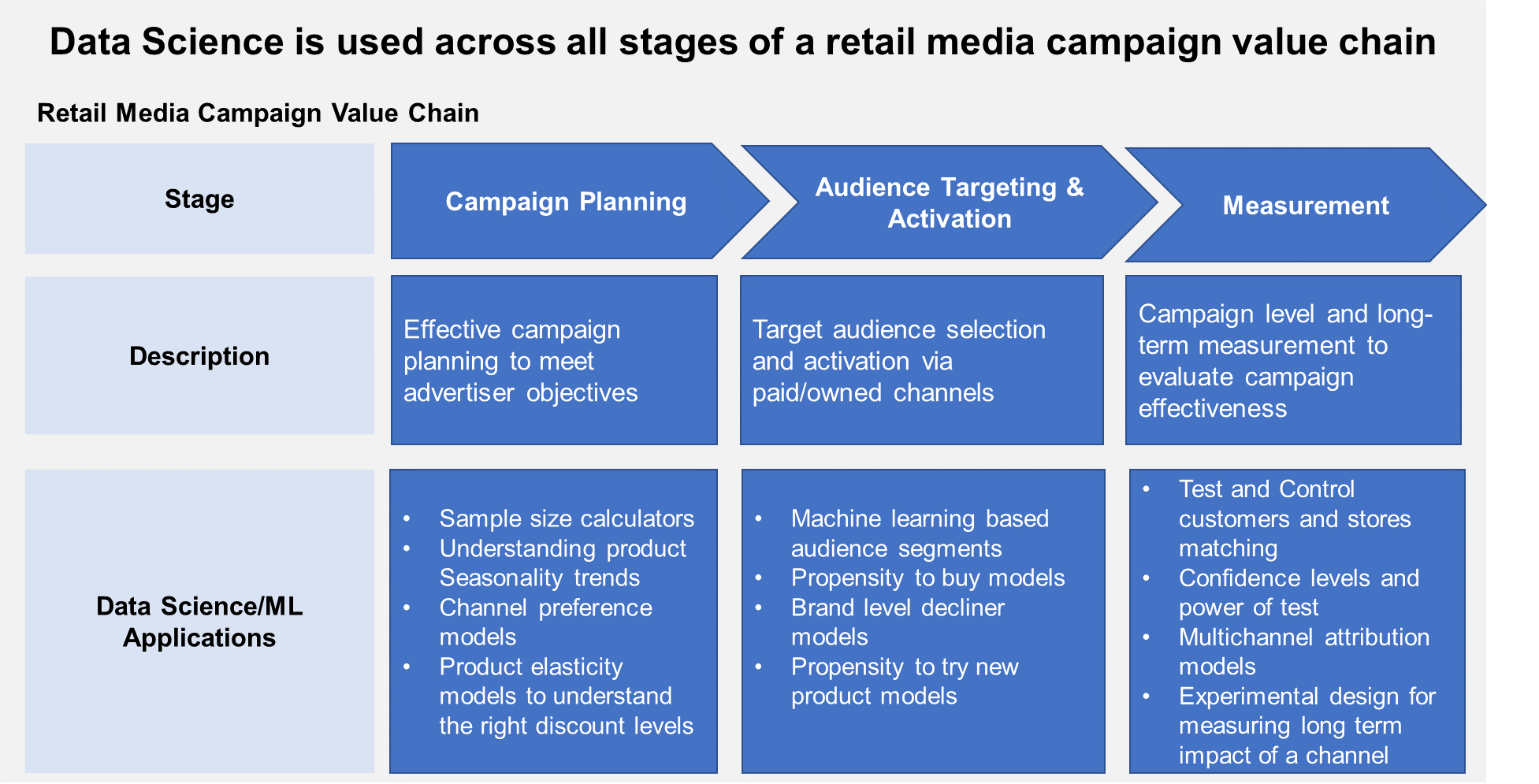The science driving retail media’s success: a look under the hood
Look around the grocery retail industry and it is increasingly evident that brands are eyeing the lucrative high-margin retail media business. This is an area in exponential growth and it’s easy to see why when you consider the pressures it can help to ease for grocery retailers – from margin pressures due to accelerated adoption of digital channels and CPG manufacturers demanding better ROI from their marketing investments, to tighter privacy standards around third-party browser cookies which make it difficult to personalise customer experience.
Retail media businesses are built on the foundations of a retailer’s first-party data, based on customers’ online and instore transactions. This foundation allows CPG (Consumer Packaged Goods) brands to target audiences based on actual purchase behaviour and understand campaign effectiveness through closed-loop reporting – delivering personalised shopping experiences to customers in the process. Retailers are building the retail media ecosystem to deliver on this ‘win-win-win’ promise for all stakeholders and the rewards can be lucrative.
This opportunity has promoted as shift in retailer focus and they are working hard to develop new capabilities and tech-stacks in the areas of data management, data science and audience management in order to capitalise. For most of the retailers, these are new capabilities and so they do not necessarily have the right expertise in-house to build and deploy them at scale. The solution lies in implementing a combination of strategies including bringing in outside talent with relevant experience, setting-up in-house digital centres of excellence and working with third parties.
However, despite these opportunities, the data science capabilities needed to power the retail media business (both in terms of building the right audiences as well as measuring campaign success for CPGs based on robust approaches) are receiving much less attention from the retailers than they ideally should.
To highlight this, let’s examine the role and the requirements of data science in retail media.
Identifying the value chain
The value chain of a retail media campaign involves three facets; campaign planning, audience targeting and activation, and measurement. Data science and machine learning algorithms play an important role across all stages of this value chain and I have highlighted some illustrative use-cases at different stages of a retail media campaign below.
1. Campaign planning
At this stage, CPG brands are typically interested in understanding which types of audience segments to target, when to target them, which channels to target them through and what is the right discount to offer, amongst others. Some examples of the underlying machine learning algorithms here include product seasonality models, understanding customers’ propensity to respond to different advertising channels and price elasticity models.
The campaign planning stage also includes identifying the right sample size of targeted customer base or stores to be able to effectively measure the campaign impact against control groups.
2. Audience targeting and activation
Traditionally, CPGs brands have been happy with targeting audiences based on demographics, intent or basic behavioural segments such as ‘past buyers’. Now they are now interested in getting to the next stage. Retail media lends itself really well to more sophisticated machine learning-based audiences such as customers likely to decline in future, new product experimenters and brand switchers. Dunnhumby’s own experience in grocery retail shows us that the science-based audiences perform much better, resulting in up to 2x uplift in return on advertising spend compared to descriptive audiences.
Although retail media monetisation opens-up a new high margin new revenue stream for retailers, they need to ensure that the focus on maximising revenues does not come at the cost of customer experience. For example, customers are not likely to have a very positive experience if they are targeted with products that they are not likely to purchase, or they are targeted with multiple offers on similar products from competing brands at the same time. This makes it imperative for retailers to have effective ‘air traffic control’ systems across all media channels, which includes ecommerce platforms, in-store and offline.
3. Measurement
Finally, since closed-loop measurement is one of the key drivers behind the adoption of retail media, the CPG brands expect that the underlying measurement methodologies are robust.
The best-in-class measurement solutions ensure:
- That the sample size of targeted audiences/stores is sufficient to measure the incremental impact of the campaign
- That the test and control customers/stores are well matched before the campaign
- That the reported incremental impact is backed by appropriate statistical confidence levels and power
This is something which is done poorly all too often in the industry today, given that campaign reporting is based on clicks and conversions and not incremental uplift driven by the campaign.
As the retail media ecosystem gains more maturity, CPG brands would also be keen to invest in omni-channel campaigns to drive better customer engagement and ROI on their marketing investments. Unlike pureplay digital channels, retail media includes both digital (onsite/offsite/email etc) and non-digital (direct mails, Instore POS etc) channels. This implies that the underlying multichannel attribution algorithms will need to be evolved for the different use cases in retail media.
Retailers also need to have the right combination of tools and experiments to understand the long-term impact. This includes the long-term impact of each of the retail media channels and their combinations on customer retention and driving incremental sales.
For example, a particular channel may drive short-term customer engagement but may not necessarily drive customer retention in the longer-run. Understanding these nuances can help retailers design the right incentives for CPG brands to invest in channels which work best for their customer base.
Unlocking potential with data science
The opportunities are plentiful and tangible, but strong data science capabilities are key to building a sustainable media business that can deliver a sales uplift for retailers, better return on actual spend for brands and enhance customer satisfaction and loyalty too.
Building the right underlying data architecture, technical infrastructure, people skills and leadership vision to harness data science at scale can go a long way in driving a successful customer first retail media business.
Want to know more about how dunnhumby can help with retail media? Visit dunnhumby.com/retailers/retail-media/
TOPICS
RELATED PRODUCTS
Make Retail Media work for your business with Customer Data Science
Retail Media solutionsHelping brands get the most from retail media
Audience Targeting solutionsThe latest insights from our experts around the world
A bold look at the future of retail at the 2025 Retail Innovation Forum
“Contactability”: the bridge between strategy and the customer




